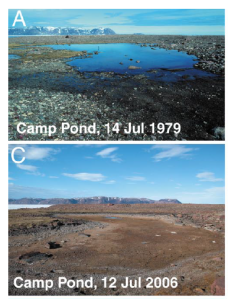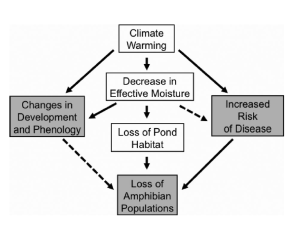The majority of our world’s water bodies are small. There may be as many as 3 billion small ponds and 29 million small streams in the world. These small water bodies are incredibly important for wildlife habitat, biogechemical cycling, and groundwater recharge. Yet, small water bodies are also among the most threatened by climate change. Small water bodies have lower volumes of water and are often shallow, making them more susceptible to changes in temperature and precipitation.
Warming temperatures
With climate change, temperatures are rising globally (see our previous post). Increasing temperatures can stress small water bodies in many ways:

Water bodies, like Camp Pond in the Arctic, that were once permanent are now experiencing seasonal drying due to warmer temperatures (Smol and Douglas 2007).
- Increased temperatures increase evapotranspiration from water bodies, meaning that more water is lost to the atmosphere through evaporation and plant transpiration. As a result, small water bodies can quickly lose water in the heat. Many small water bodies are already temporary, and may dry earlier, while permanent water bodies may begin drying up seasonally (like these Arctic ponds, pictured right). Holding water for less of the year can change what animals live there and alter biogeochemistry (e.g., greenhouse gas emissions, nutrient cycling).
- Small water bodies already exhibit extreme temperature changes during the day compared to larger systems (up to 7° C in some ponds). With warming temperatures, water temperatures may become more extreme, with severe consequences. Many animals require cooler waters to survive; therefore, we may expect to see communities shift with warmer waters. For instance, cold-water fish (such as salmon) may be replaced by warm-water fish in a warmer world. Here in the Pacific Northwest, streams are warming and are expected to increasingly stress our salmon and trout species, which are valuable regional resources.
Altered precipitation
Climate change also means altered precipitation patterns. Generally, we can expect changes in the timing of precipitation (more in the winter, less in the summer) and more extreme precipitation events. Small water bodies will be very sensitive to these changes as their water levels often fluctuate with precipitation. If rain events become more intense but more spread out, ponds and streams may fill and dry multiple times in a season, making it hard for organisms (like tadpoles and salamander larvae) to survive to metamorphosis. If there is more water in the winter and less in the summer, this means that small ponds and streams may not hold water in the summer at all. This means loss of habitat, less drinking water for animals, and less groundwater recharge.

Diagram of how climate change (including increased temperatures and reduced precipitation) can lead to amphibian declines in Yellowstone National Park (McMenamin et al. 2008)
What can be done?
Besides combatting climate change directly by reducing greenhouse gas emissions, we can still help support small ponds and streams and the creatures that live there by:
- Planting riparian buffers around small streams and ponds that provide canopy cover, which provides shade and can reduce water temperatures. This is a particularly helpful strategy for protecting salmon in the Northwest.
- Removing non-native fish species from small water bodies. Amphibians often cannot survive under intense predation pressure from non-native fish, and fish are often stocked into permanent small ponds. As temporary ponds dry up, native amphibians will need to seek refuge in permanent water bodies, but many are currently unsuitable due to non-native fish.
- Improving and increasing aquatic habitat, including providing more habitat complexity with vegetation, reconnecting rivers and wetlands, and restoring degraded habitat. Having more available habitat on the landscape can help protect aquatic animals from the stress of climate change.
